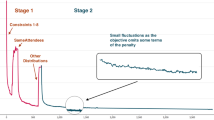Abstract
We propose in this paper a new approach for tackling constrained course scheduling problems. The main idea is to decompose the problem into a series of easier subproblems. Each subproblem is an assignment type problem in which items have to be assigned to resources subject to some constraints. By solving a first series of assignment type subproblems, we build an initial solution which takes into account the constraints imposing a structure on the schedule. The total number of overlapping situations is reduced in a second phase by means of another series of assignment type problems.
The proposed approach was implemented in practice and has proven to be satisfactory.
Preview
Unable to display preview. Download preview PDF.
Similar content being viewed by others
References
Balas, E. and Xue, J., “Minimum weighted coloring of triangulated graphs, with application to maximum weight vertex packing and clique finding in arbitrary graphs”, SIAM J. Comput. 20/2 (1991) 209–221.
Carlson, R.C. and Nemhauser, G.L., “Scheduling to minimize interaction cost”, Operations Research 14 (1966) 52–58.
Edmonds, J. and Karp, R.M., “Theoretical improvements in algorithmic efficiency for network flow problems”, Journal of the A.C.M. 19/2 (1972) 248–264.
Ferland, J.A. and Lavoie, A., “Exchanges procedures for timetabling problems”, Discrete Applied Mathematics 35 (1992) 237–253.
Friden, C., Hertz, A. and de Werra D., “TABARIS: an exact algorithm based on tabu search for finding a maximum independent set in a graph”, Computers and Operations Research 17 (1990) 437–445.
de Gans, O.B., “A computer timetabling system for secondary schools in the Netherlands”, European Journal of Operational Research 7 (1981) 175–182.
Garey, M.R. and Johnson, D.S., “Computers and Intractibility: a Guide to the Theory of NP-Completeness”, Freeman, New York (1979).
Glover, F., “Tabu Search, Part I”, ORSA Journal on Computing 1 (1989) 190–206.
Glover, F., “Tabu Search, Part II”, ORSA Journal on Computing 2 (1990) 4–32.
Hertz, A. and Robert V., “Constructing a course schedule by solving a series of assignment type problems”, ORWP 94/10, Dept of Maths, EPFL, Switzerland (1994).
Mannino, C. and Sassano A., “An exact algorithm for the stable set problem”, IASI-CNR Report No. 334, Rome, Italy (1992).
Mulvey, J.M., “A classroom/time assignment model”, European Journal of Operational Research 9 (1982) 64–70.
Ross, C.T. and Soland, R.M., “A Branch and Bound Algorithm for the Generalized Assignment Problem”, Mathematical Programming 8 (1975) 91–103.
Tripathy, A., “A Lagrangian relaxation approach to course scheduling”, Journal of the Operational Research Society 31 (1980) 599–603.
de Werra, D., “An introduction to timetabling”, European Journal of Operational Research 19 (1985) 151–162.
Author information
Authors and Affiliations
Editor information
Rights and permissions
Copyright information
© 1996 Springer-Verlag Berlin Heidelberg
About this paper
Cite this paper
Robert, V., Hertz, A. (1996). How to decompose constrained course scheduling problems into easier assignment type subproblems. In: Burke, E., Ross, P. (eds) Practice and Theory of Automated Timetabling. PATAT 1995. Lecture Notes in Computer Science, vol 1153. Springer, Berlin, Heidelberg. https://doi.org/10.1007/3-540-61794-9_71
Download citation
DOI: https://doi.org/10.1007/3-540-61794-9_71
Published:
Publisher Name: Springer, Berlin, Heidelberg
Print ISBN: 978-3-540-61794-5
Online ISBN: 978-3-540-70682-3
eBook Packages: Springer Book Archive




